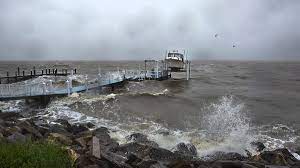
After being downgraded from a tropical storm, Ophelia on Sunday still posed a risk of coastal flooding and heavy rains from Washington, D.C. to New York City, with coastal flood warnings remaining in effect for parts of the Mid-Atlantic region, the U.S. National Hurricane Center said.
But as Ophelia weakens, a new tropical storm — Philippe — is brewing in the Atlantic.
As of 5 a.m. Sunday, the hurricane center said Ophelia was located about 85 miles (135 kilometers) south of Washington, D.C., with maximum sustained winds of 25 mph (35 kph) and higher gusts. The storm is expected to continue moving north-northeast before turning east on Sunday night, then continue weakening over the next two days.
Meanwhile, Tropical Storm Philippe was 1,155 miles (1,860 kilometers) west of the Cabo Verde Islands, which are off the west coast of Africa. That storm had maximum sustained winds of 45 mph (75 kph).
Even though Ophelia has been downgraded, the center warned Sunday that swells generated by the storm will affect much of the U.S. East Coast through the weekend, likely causing life-threatening surf and rip currents. Ophelia is also expected to produce 1 to 3 inches (2.5 to 7.6 centimeters) of additional rainfall through Sunday night in portions of the Mid-Atlantic to southern New England. Isolated river flooding is also possible in areas of heavier rainfall, the center said.
Some New Jersey shore communities, including Sea Isle City, already experienced flooding Saturday. Thousands remained without power Sunday in New Jersey. NJ.com reported more than 6,000 customers without power Sunday morning in the state, down from a high of 13,000, with more than half of the remaining outages among Jersey Central Power and Light customers in Monmouth County.
National Weather Service forecasters said numerous communities reported coastal flooding; a video posted on the Mount Holly NWS site said many streets were flooded in Brielle, New Jersey during high tide. Some flooding and road closures were reported in coastal communities in Delaware as well. A number of events scheduled in the region and in the Philadelphia area were canceled due to the storm.
The storm came ashore near Emerald Isle, North Carolina, on Saturday morning with near-hurricane-strength winds of 70 mph (113 kph), but winds weakened as the system traveled north, the center said.
Videos from social media showed riverfront communities in the state such as New Bern, Belhaven and Washington experiencing significant flooding. The extent of the damage was not immediately clear.
Even before making landfall, Ophelia proved treacherous enough that five people, including three children, had to be rescued by the Coast Guard on Friday night. They were aboard a 38-foot (12-meter) catamaran anchored in Lookout Bight in Cape Lookout, North Carolina, stuck in choppy water with strong winds.
A few thousand North Carolina homes and businesses remained without electricity across several eastern counties as of Sunday morning, according to poweroutage.us, which tracks utility reports.
“When you have that slow-moving storm with several inches of rain, coupled with a gust that gets to 30, 40 miles per hour, that’s enough to bring down a tree or to bring down limbs,” Duke Energy spokesperson Jeff Brooks told WTVD-TV on Saturday.
Also on Saturday, Greenville Police posted a video on Facebook of an officer rescuing a small pit bull from flood waters. Police said the dog was tied to a fence and “just inches from drowning” when Officer B. Schultz responded after someone called authorities about the animal. The dog is safe and Animal Protective Services has opened an investigation, police added.
Brian Haines, a spokesperson for the North Carolina Division of Emergency Management, said there were reports of downed trees but no major road closings. As a precaution, swiftwater rescue teams were staged around eastern North Carolina in case rescues were needed, according to the North Carolina Department of Public Safety. One team helped the Beaufort County Sheriff’s Office evacuate 15 people from the Twin Lakes Campground, located between the Pamlico River and the Chocowinity Bay, Haines said on Sunday.
At the southern tip of North Carolina’s Outer Banks, event organizers planned on Sunday to salvage some of the weekend’s long-running Beaufort Pirate Invasion, a multiday event centering on the 1747 Spanish attack on the town. Winds tore down the big tent for a banquet planned for Saturday and several others were damaged or shredded.
The governors of North Carolina, Virginia and Maryland each declared a state of emergency on Friday.
It is not uncommon for one or two tropical storms, or even hurricanes, to develop off the East Coast each year, National Hurricane Center Director Michael Brennan said.
“We’re right at the peak of hurricane season. We can basically have storms form anywhere across much of the Atlantic basin,” Brennan said in an interview Friday.
Scientists say climate change could result in hurricanes expanding their reach into mid-latitude regions more often, making storms like this month’s Hurricane Lee more common.
One study simulated tropical cyclone tracks from pre-industrial times, modern times and a future with higher emissions. It found that hurricanes would track closer to the coasts, including around Boston, New York City and Virginia, and be more likely to form along the Southeast coast.
In some areas where the storm struck Saturday, the impact was modest. Aaron Montgomery, 38, said he noticed a leak in the roof of his family’s new home in Williamsburg, Virginia. They were still able to make the hour-long drive for his wife’s birthday to Virginia Beach, where he said the surf and wind were strong but the rain had stopped.
“No leak in a roof is insignificant, so it’s certainly something we have to deal with Monday morning,” he said.
___
Ungar reported from Louisville, Kentucky. Mattise reported from Nashville, Tennessee. AP Radio reporter Jackie Quinn in Washington and AP writers Brian Witte in Annapolis, Maryland, Ron Todt in Philadelphia, Sudhin Thanawala in Atlanta and Christopher Weber in Los Angeles contributed.






